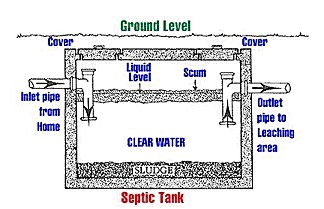How Your Septic System Works
A septic system has two major components: a septic tank and a drain field.
Septic Tank: Waste water flows from the house to the septic tank. The tank is designed to retain waste water and allow heavy solids to settle to the bottom. These solids are partially decomposed by bacteria to form sludge. Grease and light particles float, forming a layer of scum on top of the waste water. Baffles are installed at the inlet and outlet of the tank to help prevent scum and solids from escaping. Newer septic tanks can have a partial concrete dividing wall in the center, thus making two compartments. This helps ensure the sludge does not get forced out of the baffle into the drain field. Newer tanks can also have two manhole covers, one above each baffle.

Drain field (Trench): A solid pipe leads from the septic tank to a distribution box where the waste water is channelled into one or more perforated pipes set in trenches of gravel. Here the water slowly infiltrates (seeps) into the underlying soil. Dissolved wastes and bacteria in the water are trapped or adsorbed to soil particles or decomposed by micro-organisms. This process removes disease-causing organisms, organic matter, and most nutrients (except nitrogen and some salts). The purified wastewater then either moves to the ground water or evaporates from the soil. Trench systems are the most common type of system used in new home construction.

Is septic tank pumping really necessary?
Routine pumping of your septic tank protects your septic drain field and will greatly extend the life of your septic system. It is important to know how a septic tank works and what happens when you don't pump your septic tank. Then you will understand why you should pump your tank regularly.
The sewage from the house or building enters the tank through the inlet pipe and baffle. The baffle deflects the water and waste down into the liquid that is in the tank. There the solids and grease separate. The grease forms the scum layer on top of the water and the sludge settles to the bottom of the tank.
In a properly maintained septic tank there is a relatively clear liquid in the middle that is called effluent. When wastewater is added to the tank the liquid level rises and the effluent flows through the outlet baffle to the distribution box where it gets dispersed to the septic field.
If you don't have your septic tank pumped out frequently enough, the effluent retention time is greatly reduced.
What does that mean? . . . the liquid area between the scum layer and the sludge becomes too small and the solids don't have a chance to separate into scum and sludge.
The result. . . solids get pushed out in to the distribution lines and clog the drain field.
Sewage Backups:You should pump the septic tank before it is backing up in to the house or onto the lawn. By this time, pumping the tank is usually a short term remedy, the reason for the backup needs to be determined. Quite often a septic tank that has been neglected will backup because the distribution lines and or drain field has clogged with sludge. The solution ends up being a major repair or expensive replacement.
Septic Effluent on the Lawn: Strong septic odor or effluent puddles on the lawn in the drain field area is a good indicator of a septic tank problem. This will motivate people to pump their septic tank, but pumping the tank now is a very temporary solution. Effluent on the lawn indicates that a major repair or replacement is necessary. For septic tank or system problems like these, contact Edenflo Pump Truck Services
Sale of the House: Many times a realtor will recommend that the septic tank be pumped out prior to the sale of a home. It is a good idea to do this in conjunction with a septic system inspection by a certified inspector. Not everyone wants to know the details of how a septic tank works but you should know how frequently you should pump your septic tank.
To determine what pumping schedule is good for your septic system there are important factors to consider:
- How many people are using the system on a regular basis?
- The capacity of your septic tank. The smaller the tank the smaller liquid area is between the scum layer and the sludge layer in the tank.
- How old is the system?
- Has the system been properly maintained since originally installed?
Tips:
- Only discharge biodegradable wastes into system.
- Divert surface runoff water from roofs, patios, driveways, and other areas away from your drain field.
- Keep your septic tank cover accessible.
- Have your septic tank pumped regularly. It should also be inspected for leaks, cracks, and to make sure the exit baffle is in place.
- Compost your garbage or put it in the trash.
Don't:
- Use a garbage disposal. These can double the amount of solids added to the tank!
- Flush sanitary napkins, tampons, disposable diapers, condoms and other non biodegradable products into your system.
- Dump solvents, oils, paints, thinners, disinfectants, pesticides or poisons down the drain which can disrupt the treatment process and contaminate the groundwater.
- Dig in your drain field or build anything over it.
- Drive over your drain field or compact the soil in any way.
- Do not plant trees or shrubbery in the absorption field area. The roots can get into the lines and plug them. Grass is the only thing that should be planted on or near a drain field.
Do not cover the absorption field with hard surfaces, such as concrete or asphalt.





